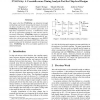48 search results - page 5 / 10 » Seven Habits of Highly Successful Input Modelers |
JAL
2008
13 years 7 months ago
2008
Biological systems are far more complex and robust than systems we can engineer today. One way to increase the complexity and robustness of our engineered systems is to study how ...
TCS
2008
13 years 7 months ago
2008
Formalized study of self-assembly has led to the definition of the tile assembly model, a highly distributed parallel model of computation that may be implemented using molecules ...
ATAL
2005
Springer
14 years 1 months ago
2005
Springer
A survivable agent system depends on the incorporation of many recovery features. However, the optimal use of these features requires the ability to assess the actual state of the...
ICCD
2004
IEEE
14 years 4 months ago
2004
IEEE
This paper describes XTalkDelay, an industrial-strength methodology and tool for measuring the impact of crosstalk on delays of paths in a design. The main cornerstone of XTalkDel...
ICRA
2006
IEEE
14 years 1 months ago
2006
IEEE
– We address the problem of knee pathology assessment by using screw theory to describe the knee motion and by using the screw representation of the motion as an input to a machi...

